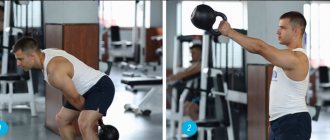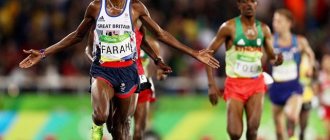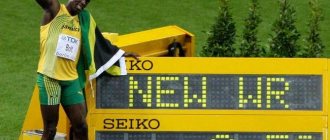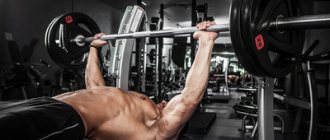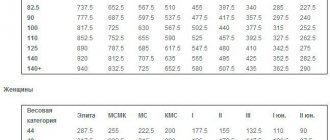Currently, one can observe an increased interest of the strong half of humanity in kettlebell lifting. Many young guys began to engage in this sport, accordingly, more sections began to be formed, the number of competitions, the scale of which is very different, is increasing. Kettlebell lifting does not require large expenses, and passing the standards is not so difficult. Several positive aspects can be highlighted.
Conditions for performing exercises
Having dealt with the exercises themselves, we can move on to the conditions and standards of kettlebell lifting. So, for all three types of exercises there are certain rules that must be followed, namely:
- The athlete is given ten minutes to complete this task.
- In each exercise it is necessary to fix the weight.
- You must always keep your balance.
It is worth taking into account that:
- The double event consists of a clean and jerk and a snatch, and points for them are awarded separately: 1 clean and jerk = 1 point, 1 snatch = 0.5 points.
- Mass categories are assigned at any competition.
- The rank of Candidate Master of Sports (CMS) is awarded at competitions of a higher status.
- The rank of Master of Sports (MS) is awarded in the semi-finals of the Russian Championship.
Important qualities of an athlete
The main physical qualities that an athlete involved in kettlebell lifting must have are, of course, endurance and strength. Although other qualities are also important. Since age does not matter much, it is possible to achieve great results and reach certain standards at any age. Although kettlebell lifting has quite complex standards.
In kettlebell lifting, as in any other, there are categories that are approved and which any athlete can take.
Standards for master of sports in kettlebell lifting
The table also contains data for candidates for master of sports (CMS) and international masters of sports (MSMS).
Classic men's biathlon:
| Athlete weight | Kettlebell weight - 32 kilograms | ||
| Master of Sport | MSMK | KMS | |
| 63 kilograms | 100 points | 170 points | 70 points |
| 68 kilograms | 115 points | 185 points | 78 points |
| 73 kilograms | 130 points | 195 points | 86 points |
| 78 kilograms | 140 points | 205 points | 97 points |
| 85 kilograms | 150 points | 215 points | 111 points |
| 95 kilograms | 155 points | 223 points | 120 points |
| 105 kilograms | 160 points | 220 points | 115 points |
| +105 kilogram | 165 points | 222 points | 120 points |
Long cycle push of two weights. Number of lifts.
Men:
| Athlete weight | Kettlebell weight - 32 kilograms | ||
| MS | MSMK | KMS | |
| 63 kilograms | 47 climbs | 48 climbs | 28 climbs |
| 68 kilograms | 44 climbs | 57 climbs | 35 climbs |
| 73 kilograms | 49 climbs | 64 lifts | 41 lifts |
| 78 kilograms | 53 climbs | 69 climbs | 45 climbs |
| 85 kilograms | 57 climbs | 75 climbs | 48 climbs |
| 95 kilograms | 60 lifts | 80 lifts | 52 climbs |
| 105 kilograms | 62 lifts | 82 lifts | 55 climbs |
| +105 kilogram | 64 lifts | 85 climbs | 57 climbs |
Jerk. Number of lifts.
Women:
| Athlete weight | Kettlebell weight - 24 kilograms | ||
| MSMK | MS | KMS | |
| 58 kilograms | 120 lifts | 100 lifts | 55 climbs |
| 63 kilograms | 130 climbs | 110 lifts | 63 lifts |
| 68 kilograms | 140 climbs | 120 lifts | 69 climbs |
| 68+ kilograms | 150 climbs | 130 climbs | 73 lifts |
Jerk
A.7.15
The exercise is performed in one step. The participant, having completed a preliminary swing of the weight between his legs, must lift the weight up with a continuous movement and fix it on his straight arm. After lifting the weight up, at the moment of fixation, the legs and torso should be straightened and motionless, the free hand should be stopped. Bending and twisting of the body, flexion at the hip joint while fixing the weights is not allowed. After fixation, the participant, without touching the body with the weight, lowers it down to swing and perform the next lift.
A.7.16
Changing hands is done once, at the bottom.
A.7.17
One additional swing is allowed during the start and during the change of hands (interception).
A.7.18
The “Stop” command is given: - when stopping the weight on the shoulder or platform, when performing the second swing on the second hand; -If the “Transfer” command is not executed.
A.7.19
The command “Do not count” is given: - when “pressing” the weight; - in the absence of fixation of lifting the weight above the head (visible stoppage of movement of all parts of the body and weight); - when touching with your free hand any part of the body, weights or platform;
A.7.20
The “Shift” command is given when performing the second swing on the first hand.
Bodymaster.ru recommends Training Plans:
The “long cycle push” exercise differs from a regular push in that the athlete, after lifting two weights with both hands, drops the weights to his feet and, without placing them on the platform, throws them back onto his chest.
Long cycle kettlebell push
Kettlebell lifting, by its specificity, is a cyclic sport, with a fairly long duration of work in competitive conditions. A weight lifter must lift weights (weights) for 10 minutes at the highest possible pace; accordingly, the leading motor quality in this sport is strength endurance. All this is reflected in the specifics of the training process in kettlebell lifting. In addition to training strength abilities, a weight lifter also needs to develop aerobic endurance. According to regulatory documents, those who are at least 12 years old are allowed to engage in kettlebell lifting.
The content and specificity of training in kettlebell lifting is determined by the age and qualifications of those involved. At the initial stages of kettlebell lifter training, general physical training tools predominate for the development of strength (exercises with weights) and endurance (running, outdoor games). The use of this kind of means allows us to ensure the formation of a physical base for subsequent in-depth specialization. Special exercises with weights are used to a lesser extent; the main emphasis in their use is on mastering the technique of competitive exercises. As the level of training of the trainees increases, the share of special exercises increases, the intensity of the load increases, the focus of the training process on in-depth specialization is observed, and the share of general physical training decreases.
The main means of training in kettlebell lifting are exercises that can be divided into competitive, special-preparatory and general developmental. Also, in relation to kettlebell lifting, some experts use a simpler classification of exercises: exercises with weights and exercises without weights. A number of exercises used in the training process of weightlifters are borrowed from other sports.
General developmental exercises are presented both as means for developing aerobic endurance and as means of strength training. To train endurance, weightlifting training includes running for medium and long distances. To increase the effectiveness of running exercises, the whole range of endurance training methods is used: continuous-uniform (running a distance at a constant speed), continuous-uneven (running a distance with periodic accelerations) and interval (running a distance several times with strictly limited rest intervals). As part of strength training, exercises with various weights are used for the main muscle groups; preference is given to basic exercises (presses, rows, squats, pull-ups, bends, etc.), exercises from weightlifting can also be included in the training. Exercises to develop strength are usually performed with rest intervals until complete recovery; the weight of the weight is usually 40% - 80% of the maximum, while exercises with a weight of 40% are recommended to be performed at the highest possible pace.
Competitive and special-preparatory exercises include a set of various exercises with weights. Competitive and special-preparatory exercises with kettlebells are used to improve a complex of motor abilities specific to kettlebell lifting. Competitive exercises are represented by a kettlebell snatch and a kettlebell push in a long and short cycle. Special preparatory exercises include various options for lifting weights similar to competition ones in terms of technique, rhythm and tempo of work, alternating tension and relaxation of various muscle groups. Special preparatory exercises can be performed with one or two weights, and the weight of the apparatus can vary widely. Based on the specifics of competitive activity, within the framework of the educational and training process, competitive and special preparatory exercises can be performed using various methods, which are selected depending on the tasks solved by the athlete in a given period of sports training. In kettlebell lifting, as part of special work, the following training methods are used: uniform, variable, interval, repeated and competitive. The uniform method involves performing competitive and special-preparatory exercises at the same pace, with the exercise being performed once. The pace of the exercise is determined based on the heart rate readings. The heart rate at the end of the exercise should be approximately 75% of maximum (220 beats/min minus age). The main goal of this method is to increase the aerobic capacity of the athlete’s body. The alternating method involves performing several sets of an exercise with kettlebells of different weights. In the first half of the approaches, the weight of the kettlebell increases, and in the second half it decreases. In this case, a constant pace of performing the exercise must be maintained, and the number of repetitions is determined individually. The alternating method is intended primarily to increase the strength component of the complex of motor abilities of a weightlifter and improve exercise technique. The interval method involves performing exercises in short bursts, which are alternated with strictly regulated rest periods. This method is used to increase the pace of the exercise. There are two variants of the interval method: sprint (duration of each series is 15 - 30 seconds at maximum pace), tempo version (duration of each series is 1-2 minutes). This method is also preferable for experienced athletes. The repeated method involves performing an exercise with several approaches, the duration of each approach is less than in competitions and ranges from three to five minutes. Rest intervals between approaches last until the athlete fully recovers. This method is also effective for improving exercise technique. The competitive method involves performing an exercise with a duration and tempo as close as possible to the competition conditions. This method is used for direct preparation for competitions, determining your maximum at the current time. The choice of a specific method depends on the planned volume and intensity of the load, the ability of the athlete’s body to adapt to physical activity.
In addition to mastering the technique of competitive exercises and training the athlete’s motor abilities, in order to achieve a high result, it is important to achieve a high ability to operate all body systems that ensure oxygen consumption and utilization, which in turn makes it necessary to master the skills of proper breathing when performing special exercises. According to widespread recommendations, you should breathe through your mouth, deeply and rhythmically, and exhale fully and intensely. When performing a kettlebell snatch, while lifting the weight from the starting position, a deep breath is taken, when the kettlebell is at the top, an exhalation is made and a small inhalation is made, when the kettlebell is lowered down, a deep exhalation is made - during one cycle of the kettlebell jerk, two inhalations and two exhalations are made. When performing a push of weights in the starting position, inhale, when doing a half squat, exhale deeply, then before pushing out, inhale, in the position of fixing the weights, exhale and inhale a little, when lowering the weights to the chest, exhale deeply—three breaths are taken in one cycle of pushing the weights and three exhalations.
Educational and training sessions in kettlebell lifting are built according to the classic three-component scheme: preparatory part, main part and final part. In the preparatory part of the lesson, athletes perform a general warm-up of the body; this may also include specialized exercises with light weights to prepare athletes for a specific load. The duration of the preparatory part is on average 15 minutes. As part of the final part, in order to speed up the recovery processes, stretching of the main muscle groups and special exercises for compression relief of the spine are performed. The final part lasts about 10 minutes. The main part of the lesson is the training itself and consists of several groups of exercises performed in a certain sequence. Analysis of the training programs of weightlifting athletes shows a significant variety of training schemes used, but most often at the beginning of the main part, competitive exercises are performed, after which special preparatory exercises can be performed, at the end of the main part, as a rule, general developmental exercises for the main muscle groups are performed. The ratio of the volume of different groups of exercises is mainly determined by the qualifications of those involved. The duration of the main part is 1 - 2 hours.
Within the framework of a weekly microcycle of a kettlebell lifter, from 3 to 6 training sessions are carried out. Each lesson includes 4 - 8 exercises from all groups. Considering the long duration of special exercises with weights, the number of approaches is usually small and ranges from 1 to 4. Rest intervals between approaches can be ordinary (until complete recovery) and hard (time limited) - determined by the training method used.
The design of training complexes in kettlebell lifting is carried out according to certain rules. When describing a training task, a number of parameters are indicated: serial number, name of the exercise, weight of the apparatus, number of repetitions and approaches, rest time and work time. The name of the exercise can be written in full or in the form of abbreviations: P - snatch, T - short cycle jerk, DC - long cycle jerk. The weight of the projectile is indicated in kilograms. The number of repetitions can be specified specifically as a number or as a percentage of the maximum achieved. Work time and rest time are written in minutes or seconds. Also, the training task may indicate an important parameter of the weightlifter’s load - the pace of the exercise in the form of the number of lifts per minute. The above components are not always fully represented in the training task; only those that are necessary in a particular case can be indicated. For example, the weight of the apparatus may not be indicated, which implies performing the exercise with a standard weight of weights for a given time at a certain pace. Also, the time of work and the number of repetitions are not indicated at the same time (instead of repetitions, the pace of the exercise or the duration of the work may be indicated). If the exercise is performed once, then the number of approaches is not written. The rest time between approaches is indicated when performing an exercise with time-limited rest intervals. Considering all of the above, it becomes clear that the design of the task will differ when using different training methods. For example, a training task when using the uniform training method may look like this:
1. Jerk: 24 kg / 8 in min / 10 min or 1. T 24 kg / 8 in min / 10 min
which means: “Exercise number one is a 24 kg weight push, perform at a rate of 12 lifts per minute for 10 minutes.” The design of a training task using a variable training method might look something like this:
1. Clean and jerk: 24 kg / 10 min; 28 kg / 10 per min; 32 kg / 10 per min; 28 kg / 10 per min; 24 kg / 10 per min
which means: “Exercise number one, kettlebell push, perform at a pace of 10 lifts per minute, five approaches with kettlebells 24 kg, 28 kg, 32 kg, 28 kg, 24 kg.” The design of a training task using the interval training method may look like this:
1. Jerk: 32 kg / 50 / 120 sec / 3 or 1. Jerk: 32 kg / 60% / 120 sec / 3
which means: “Exercise number one, push of 32 kg weights, perform 50 times (60% of the maximum), three approaches, rest interval between approaches is 120 seconds.” The design of a training task using the repeated method is as follows:
1. Snatch 24 kg / 60 / 2 or 1. Snatch 24 kg / 60% / 2
which means: “Exercise number one, jerk a 24 kg weight, perform 60 times (60% of the maximum), two approaches.” Completing a task using the competitive method is quite simple:
Clean and jerk 32 kg / max / 10 min or Snatch 32 kg / max / 10 min
which means: “Perform a push (snatch) of a 32 kg weight as many times as possible in 10 minutes.” The design of general developmental exercises is carried out in a standard form: the name of the exercise and the number of approaches multiplied by the number of repetitions. For example:
Squats with a barbell on the shoulders: 3x15
which means: “Perform squats with a barbell on your shoulders 3 sets of 15 times, select the weight yourself.” Below, as an example, is a training complex for a kettlebell lifting lesson designed according to a similar scheme:
1. Double kettlebell push: 24 kg / 80% / 120 sec / 3 2. Kettlebell snatch: 24 / 70% / 120 sec / 2 3. Overhead barbell press: 3x15 4. Squats with a barbell on the shoulders: 4x10 5 Bends over pommel horse: 3x20 6. Torso bends lying on the floor: 2xmax
It should be noted that the above schemes for designing training tasks and complexes in kettlebell lifting are not exhaustive, which is explained by the wide variety of approaches to designing training tasks among specialists in this sport.
As an example of organizing the training process in kettlebell lifting, we can cite several plans for weekly microcycles. The first training plan is presented as a weekly microcycle of three sessions and is intended for beginner weightlifters; the author’s terminology is preserved:
Monday
1. Jumping from a low squat with a kettlebell behind the head: 16 kg x 10-15 times / 2 2. Two-handed kettlebell snatch: 24 kg x 10-15 times / 2 3. Double kettlebell push press: 16 kg x 10-15 times / 2 4. One-arm kettlebell snatch: 16 kg x 10-15 times / 2 5. Double kettlebell deadlift: 16 kg + 16 kg x 10-15 times / 2
Wednesday
1. Squats with weights on the shoulders: 16 kg + 16 kg x 8 times / 2 2. Raising two weights on the chest from the floor: 16 kg + 16 kg x 10-15 times / 3 3. Half squats with weights on the shoulders: 24 kg + 24 kg x 10-15 times / 3 4. Bench press: 3 x 10-15 times 5. Kettlebell push-ups with toes out: 16 kg + 16 kg x 10-15 times / 3 6. Overhead push-up : 3x10-12 times 7. Hanging on the bar for a while: 2x1 min
Thursday
1. Kettlebell swings with changing hands: 24 kg x 10-15 times / 2 2. Standing kettlebell row to the chin: 16 kg x 10-15 times / 2 3. Snatch of one kettlebell with both hands: 24 kg x 10-15 times / 2 4. Kettlebell snatch with one hand: 16 kg x 10-15 times / 2 5. Standing bends with a kettlebell in hands: 24 kg
The following training plan is presented in the form of a microcycle of four sessions and is designed for more prepared athletes, the author’s terminology is preserved:
Monday (low load)
1. Kettlebell swings with changing hands: 24 kg / 40% / 2 2. Snatch: 24 kg / 50% / 3 3. Walking with kettlebells in the hand below: 2x60 s 4. Squats with a barbell on the shoulders: 3x6-8 5. Body lifts lying on a goat: 2x12-15 6. Cross training 1 km
Tuesday (average workload)
1. Clean and jerk: 24 kg / 60% / 4 2. Shung press: 3x10-12 3. Walking with weights on straight arms at the top: 2x30 s 4. Bent-overs with a barbell in hands: 3x10-12 5. Half squats with a barbell: 3 x 20 6. Cross training 2 km
Thursday (heavy load)
1. Clean and jerk: 24 kg / 70% / 3 2. Snatch: 24 kg / 50% / 2 3. Walking with weights in the hands below: 2x60 s 4. Squats with a barbell on the shoulders: 3x6-8 5. Bent-overs with a barbell in arms: 3x10-12 6. Standing barbell press: 2x20 7. Cross training 1 km
Friday (average workload)
1. Snatch: 24 kg / 70% / 3 2. Walking with weights in the hands below: 2x30 3. Squats with a barbell on the shoulders: 3x6-8 4. Lifting the body while lying on a goat: 2x12-15 5. Bringing the legs to the bar: 2x10
When planning training sessions, the weight of the load is indicated as a percentage most often when working with large groups of athletes; with an individual approach, instead of percentages, specific numbers for load values can be substituted, which in some cases is more convenient and practical.
When assessing the level of training load in kettlebell lifting, its volume is taken to be the number of weight lifts or the sum of kilograms lifted (tonnage) for the assessed training period. The intensity of the training load can be taken as the weight of the weights, the rate of lifting, and the number of repetitions as a percentage of the maximum. Planning the volume and content of the load in kettlebell lifting is carried out taking into account the specific stages of long-term training and taking into account the age and individual characteristics of those involved. The alternation of training loads of different levels at different periods of the training process is carried out in compliance with the principle of cyclicity, the nature of the means used varies over a wide range and is determined by the current tasks of sports training.
